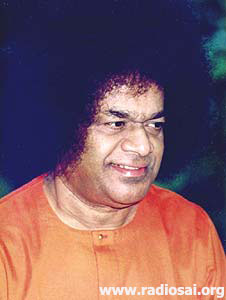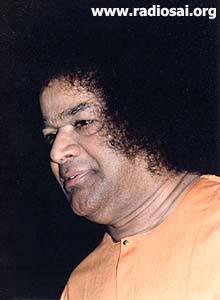 |
 |
 |
Volume
6 - Issue 02
FEBRUARY - 2008 |
CONVERSATIONS WITH SAI Satyopanishad - part 1:
CHAPTER 1 - THE INDIA ETERNAL
Prof. Anil Kumar (AK): Swami! India (Bharat) is the land of religion and spirituality. All the incarnations have taken birth in Bharat. What is the reason behind this? Bhagavan: Bharat is yogabhumi, the land of spirituality. Bharat is punyabhumi, the sacred land. Bharat is karmabhumi, the land of sacred activity. Bharat is tyagabhumi, the land of renunciation. Here saints, sages, seers, aspirants, seekers and devotees pray to God to enjoy His proximity. This necessitates the descent of God in human form or incarnation. In response to their fervent appeals and prayers, God, out of His grace and compassion, descends on earth or incarnates and moves amidst us. Devotees, then, experience bliss and follow Him. Here is an illustration. You asked why Bharat alone has always been the birthplace of the incarnations. You know that the train has an engine in the front with several carriages connected to it. The power or energy generated there in the engine pulls the carriages forward. Where do you find the driver? Naturally, he sits in the engine monitoring the train, does he not? Similarly, in the train of the world, Bharat is in the position of an engine and the carriages are the several countries attached to it. God is the driver. The engine is His place. Just as we find heat and power generated there, we also find the same elements produced as a result of sacred rituals such as yajnas and yagas (sacrifices) performed from time to time in this land of Bharat. In the great epic, the Mahabharata we find Arjuna and Bhima always following Yudhisthira. Here, Arjuna stands for intelligence, while Bhima symbolises physical strength. Now, Bharat is in the position of Yudhisthira. America is Arjuna, while Russia is Bhima. Just as you find Bhima and Arjuna obeying the command of Yudhisthira, America and Russia should follow Bharat. In the very name "Bharat" we have three letters. (Written in Telugu, "Bharat" comprises three letters). Bha, the first letter stands for bhava or feeling; ra, the second signifies raga, tune or melody; and ta, the third indicates tala or beat. Thus, Bharat is the country where the glory of God is sung with proper feeling, melody and right rhythm. This country has another name “Hindudesam” which means a country that shuns violence, 'Him' means, himsa or violence and 'du' refers to “dura” or shuns. For these reasons God has chosen to incarnate or descend in human form in Bharat. AK: Swami! We find people of every religion following a specific sacred text and a particular path. But in Sanathana Dharma (ancient Indian practice), we have numerous paths, texts, and procedures such as dualism, qualified non-dualism and nondualism, the nine paths of devotion, the six Darsanas, the four Vedas, numerous Sastras (scriptures), and so on. How are we to understand these and practice the principles of Sanathana Dharma?
Bhagavan: Sanathana Dharma is the most ancient spiritual way of life. Its diversity matches the spectrum of human behavioral tendencies, temperaments and mental attitudes. It is practical and confers divine experiences. A small example. You buy a piece of cloth and give it to a tailor to make a suit for you. The tailor will get your suit ready according to your measurements, does he not? You cannot wear a dress made for someone else. It may be too loose or too tight, too long or too short. Therefore, your dress must be according to your size. Similarly, some may like Rama, some Siva, Krishna, and so on. They find it easy to concentrate on the deity of their choice, whereas the followers of other faiths may have to wear one dress of one and the same size. Another example. You may know the nadasvaram (the South Indian musical instrument required to be played on every auspicious occasion). To maintain srti or rhythm by way of an accompaniment, one person plays an instrument in the same way all through. On the other hand, with nadasvaram you can play any number of ragas or tunes. Sanathana Dharma is like the nadasvaram. Yet another example: Whatever be the combination of optional subjects you may take in Science during your undergraduate programme, be it 'M.P.C.' (Maths, Physics and Chemistry) or 'C.B.Z.' (Chemistry, Botany and Zoology), you get a B.Sc. degree. Similarly, in the university established by Sage Vyasa, you can opt for any course like the Sastras, the Vedas, the Upanishads, etc. This is the significance of our ancient Sanathana Dharma, which gives ample freedom for you to select and follow. Here is one more example: A pharmacist and a cafe owner had a headache on the same day. Seeking relief, the pharmacist went to the cafe for a cup of coffee, and the cafe owner to the medical shop for a tablet. So, one has faith in a cup of coffee while the other trusts a tablet. In the same way, you should follow the spiritual path you believe in, and the text that is convincing and appealing to you.
AK: Swami! Muslims go to a mosque every Friday to pray (namaj), and Christians go to a church every Sunday. Then, how is it that Hindus do not meet in a temple like other religious groups? Bhagavan: You are wrong if you think Hindus should. They are not required to specially meet on a specific day like others. Why? Every Hindu has a puja room or an altar in his home particularly meant for worship. He prays there every day. So there is no need for him to assemble for mass prayer or to pray on specific days like people belonging to other religions. AK: Swami! Since God is omnipresent and omniscient, do we need temples and should we go on pilgrimage to holy places like Shirdi, Puttaparti, Tirupati, and so on? Bhagavan: This is a foolish question. You are exhibiting your ignorance and your 'fashionable' way of thinking which, more often than not, is perverted. There is no relationship between what is said and what is experienced. You say that God is everywhere. But it is merely an expression, vocal and verbal. Do you really have strong faith that God is present everywhere? Do you have that experience of the divinity, which is all pervasive? You are simply speaking like a parrot. Here is a simple example. Blood circulates throughout the body of a cow. But you can draw milk only out of the udder! You can't squeeze the ear or twist the tail of a cow to get its milk, can you? Therefore, the all pervading God can be visualised and experienced in a temple and at a holy pilgrim centre. AK: Swami! Why did the ancient rishis, sages and saints, choose forests to undertake tapas or penance? Why did they prefer solitude?
Bhagavan: There is significance undoubtedly. Why did they choose forests for penance? Here is an example. Suppose an exhibition is organised in a city. Naturally, the stalls there and the articles kept there for sales attract you. The music, eatables, clothes, etc., draw you. The exhibits attract your senses since you find them right before you. But, in a forest, there is nothing to attract or distract your attention. Solitude helps you to maintain the inner peace and tranquility needed for meditation. It provides a congenial atmosphere for spiritual life. So, saints and sages always did penance in forests. In other words, "forest" is "for rest" spiritually. AK: Swami! We don't find any understanding between any two persons, but only mutual bickering and differences. We hardly find any unity or brotherhood between man and man. What is the reason? Bhagavan: There is one thing you should clearly know when you think of unity and differences among people. What is the reason? Today there is no understanding between any two persons. The absence of understanding is the main cause of all the conflicts, enmity, and differences. Therefore, people do not adjust with others. Adjustment is possible only when there is understanding. But, today you are moving in the opposite direction. You think that you can adjust first and then understand each other. But, that is wrong. You must first understand and adjustment then becomes easy. Here is a small illustration. When there is perfect understanding between you and your wife, she does not mind if you return home late from your office. She pities you and sympathises with you. With all her concern and love, she brings you a cup of coffee. But, if by any chance, there is a slight misunderstanding, and your return from office is delayed even by five minutes, there will be a civil war at home.
Why? Misunderstanding is the cause of her inability to adjust. It makes her put questions like: "Where have you been till now? Where did you go? With whom did you spend the time?" etc. So understanding is very necessary for proper adjustment. Many problems of society today can be solved if this is realised. AK: Swami! Hindus are criticised for worshipping idols, trees, etc. Many think that this is all superstition and blind faith. What do you feel about this, Swami? Bhagavan: Bharat (India) is the spiritual centre of the world. This is the country that practised, preached and propagated that divinity exists in all the living and the nonliving, right from an atom to the entire cosmos. You will notice that here, in this country, putta (anthill), gutta (mountain), chettu (tree) and pitta (bird) are objects of veneration and worship. An anthill is worshipped as the abode of Lord Subrahmanya, a bird is respected as the vehicle of Lord Vishnu, a mountain is spiritually important as it is viewed as Govardhana lifted by Lord Krishna, and a tree is worshipped as the asvatthavriksa. All objects are divine according to our scriptures. This is not superstition. This is not in any way blind faith. Sanathana Dharma wants us to view, feel, and experience divinity everywhere. This is the spiritual path. This is the highest and noblest experience. (To be continued...) – Heart2Heart Team
|
Vol 6 Issue 02 - FEBRUARY 2008
|
Best viewed in Internet Explorer - 1024 x 768 resolution. |






